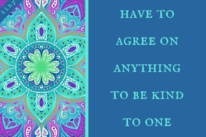
“Feelings come and go, like clouds in the sky. Conscious breathing is my anchor.” ~Thich Nhat Hanh
In today’s fast-paced world, it’s easy to find ourselves caught in a whirlwind of intense emotions.
Whether it’s the stress of looming deadlines, the anxiety of an uncertain future, or the frustration of unexpected setbacks, intense feelings often hijack our mental well-being, leaving us feeling drained and powerless in their wake.
In such moments, our instinctual response is often to either suppress these emotions or allow them to dictate our actions, leading to a cycle of reactivity and emotional turbulence.
Growing up, I learned to fear emotions. In my tumultuous home, it often felt like there was no room for feelings—they were either ignored, mocked, or punished. I adapted by suppressing my emotions and disconnecting from my heart.
I became a quiet, shy, and sensitive child who didn’t make waves, the proverbial good girl, always pleasing and performing, never complaining, saying no, or acting out. Disconnected from myself, I had trouble connecting with others.
I began disappearing into my own world. Convinced there was something wrong with me, I lived in a perpetual state of internal angst and shame, wanting and fearing connection all at once. For years I was plagued with codependency, negativity, c-PTSD symptoms, one-sided relationships, anxiety, and anger buried so deep I didn’t even see it. I lived on autopilot—successful by external standards but internally in emotional turmoil.
It was only after becoming a parent that all that I buried within began to surface, catching me off guard. Parenting, more challenging than I ever anticipated, forced me to confront the pain, trauma, and difficult truths that I had been repressing all my life. I began to unravel.
When we live on autopilot, we become slaves to our reactions, blindly following the same patterns of behavior without pausing to consider their consequences. I know I was—feeling lost in a whirlwind of suppressed emotions and disconnected from my true self.
But amidst the chaos of my internal turmoil, I discovered a transformative path forward: mindfulness. This ancient practice became my beacon of clarity in the midst of emotional storms, inviting me to step off the treadmill of reactivity and into the present moment.
By embracing mindfulness, I learned to approach my intense emotions with curiosity and compassion, gradually unraveling the layers of pain and trauma buried deep within. In the process, I unearthed a reservoir of resilience, wisdom, and love buried deep within me.
How to Process Intense Feelings with Mindfulness
Emotions are an integral part of the human experience, and they often manifest as sensations in our bodies. They arise in response to challenging situations or perceived threats, and our immediate response is often automatic and primal. However, by fostering greater self-awareness and empathy toward our own emotional experiences, we can begin to navigate the landscape of intense feelings with greater clarity and resilience.
Step 1: Name It in the body.
Think about a recent situation that stirred up strong emotions within you. It could be a disagreement with a loved one, a work-related challenge, or even a personal setback. Pause and ask yourself: What did you feel in your body during that moment? Did your chest tighten, your heart race, or your eyes well up?
When my kids were younger, I was plagued by anxiety. Between a lack of sleep, having to be “on” 24/7 as a parent, the stress of trying to make a living, and feeling all alone (we moved across the country), I was constantly on edge. And so, I would react to small things with big emotions. It always started with my body tensing up and my heart suddenly racing while thoughts like, “I can’t handle this!” ran through my head.
Emotions first show up as sensations in the body. We have no control over these natural responses—they’re programmed into our DNA. The good news is that these bodily sensations are like emotional signposts. If we pay attention, we can recognize what they are trying to tell us. And by naming what comes up, we can gain clarity and understand what is unfolding within us. It’s an empowering first step to mindful emotional processing.
Step 2: Breathe into it.
Mindfulness teaches us to pay attention. It allows us to recognize what is happening in our body, with compassion and without judgment. That awareness is power—the power to respond from our authentic selves instead of reacting from our habitual selves.
Think back to a time when you had a heated argument with a loved one. Your immediate reaction was likely intense, with emotions running high. But what if, in that moment, you had taken a deep breath and allowed yourself to pause?
When we are triggered, the primal part of our brain gets activated first, well before our intellectual brain gets the signal. The amygdala (our reptilian brain) controls our automatic reactions, which depend on our upbringing, defenses, and coping mechanisms we developed over the years. Taking a few deep breaths allows us to halt this reaction just long enough for our pre-frontal cortex and intellect to kick in.
Over time, this simple act of focusing on breathing while being flooded with waves of intense emotions helped me stay calm in stressful situations and tampered down my reactions. It was often just enough for me to regain perspective and respond as an adult, not an overwhelmed child still trying to be seen or heard. Now if I feel triggered or ungrounded, I remember to stay focused on the breath. It always carries me to the other side.
Step 3: Remember that emotions are energy in motion.
Emotions are energy, and they’re always in motion. We get stuck on feelings because we disconnect from them, repress them, and pretend they’re not there. Or we hold onto them. We let them fester. They don’t get processed and then released, so we can’t move on.
Working through emotions starts with simply allowing them to be. We’re no longer fighting them, getting stuck on them, or running from what comes up. Instead, we let the feelings come and go, without attaching a story. It’s good to practice this when you’re calm, so that you know what to do in the heat of the moment.
Learn to just notice and allow what happens to you internally. As you observe the sensations in your body and feel what comes up, bring a sense of compassion for yourself, especially if intense feelings show up. This is difficult work, so take baby steps and make sure you take care of yourself daily—body and mind.
Mindfulness teaches us to accept all emotions and increases our window of tolerance to stressors. We get more resilient and authentic. We begin to listen to our feelings with openness, non-judgment, and compassion—and that’s transformative.
Feelings are messengers. They inform us about what we value and what we don’t want. For me, the anxiety was screaming at me to start taking care of myself. I was neck-deep in raising children and working and running a house, and I neglected to show up for myself. The truth is, I was deeply unhappy, and once I accepted that, I was able to draw some boundaries and change what wasn’t working.
Think of the last time you experienced disappointment or frustration. Instead of pushing these feelings away, allow your emotions to just be there without judgment. Focus on your body. Where is that feeling located? What does it look like? What does it need from you? Whatever comes up, give it attention.
As you observe these sensations, you can journal about them, or take them for a walk. Maybe your body needs to shake it off or dance it out. Do whatever feels right to move that energy through and out of your body. By engaging with your emotions, you enable them to flow through you, rather than stagnate and fester.
Step 4: Respond from your wise self.
Awareness is half of the equation; the other half is action—and how you respond depends on your state of mind. With mindfulness, you don’t get swept up in the turmoil of emotional reactions; you’re no longer allowing autopilot to take you for a spin. Instead, you notice, breathe through what is, and tap into a higher perspective. And then you choose your response based on what makes sense for you.
Ask yourself, “What’s the best way to handle this situation?” Do you need to take action, advocate for yourself, set a boundary, reach out for support, step back and regroup, or take care of yourself to restore and rebalance your energy?
For me, overcoming anxiety was a journey of learning to recognize when anxiety arose, to breathe through the discomfort with compassion, and to choose a response that aligned with my values and well-being.
Whether it was removing myself from triggering spaces and situations, taking more time for myself, seeking support, or letting go of perfection, I started prioritizing my health and well-being. It wasn’t always easy, and I had to let some things go, but slowly I shifted toward inner peace and authenticity.
I also learned to not take things personally, recognizing that everyone experiences challenging emotions and that responding gracefully is a sign of strength.
—
If emotional regulation was not modeled for you growing up, it can feel like navigating through a minefield. For years, I struggled with understanding and managing my feelings, which, in turn, impacted my relationships, my well-being, and my overall happiness.
With mindfulness and consistent practice, however, I was able to break free from old patterns, heal from past wounds, and cultivate emotional resilience and well-being. Intense emotions started to lose their grip on me, and I became more peaceful and less reactive. I discovered the grace of self-compassion and learned to ride the waves of big feelings, knowing that they would eventually subside.
Emotions are an intricate part of our lives, and using mindfulness can help us navigate them more effectively. We don’t have to fear them. It’s possible to regulate our emotions and cultivate a more mindful and graceful approach to life’s challenges.
By actively engaging with our emotions, rather than reacting on instinct, we can unlock a newfound sense of control and wisdom, creating a more harmonious relationship with our emotions and the world around us.
About Joanna Ciolek
Joanna Ciolek is a self-taught artist, recovering self-critic, and the author of mindfulness-based prompt journals, The Art of Homecoming and The Art of Untangling. To learn mindfulness, reconnect with yourself, and begin your healing journey, join her Free Course at The Mindfulness Journal. Follow Joanna on Twitter, Instagram, and Facebook.
- Web |
- More Posts













 Though I run this site, it is not mine. It's ours. It's not about me. It's about us. Your stories and your wisdom are just as meaningful as mine.
Though I run this site, it is not mine. It's ours. It's not about me. It's about us. Your stories and your wisdom are just as meaningful as mine. 